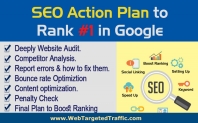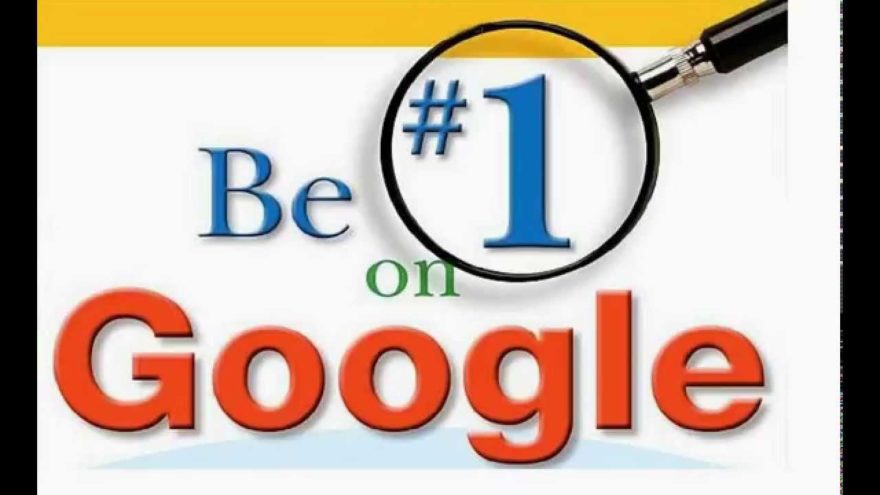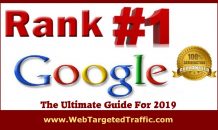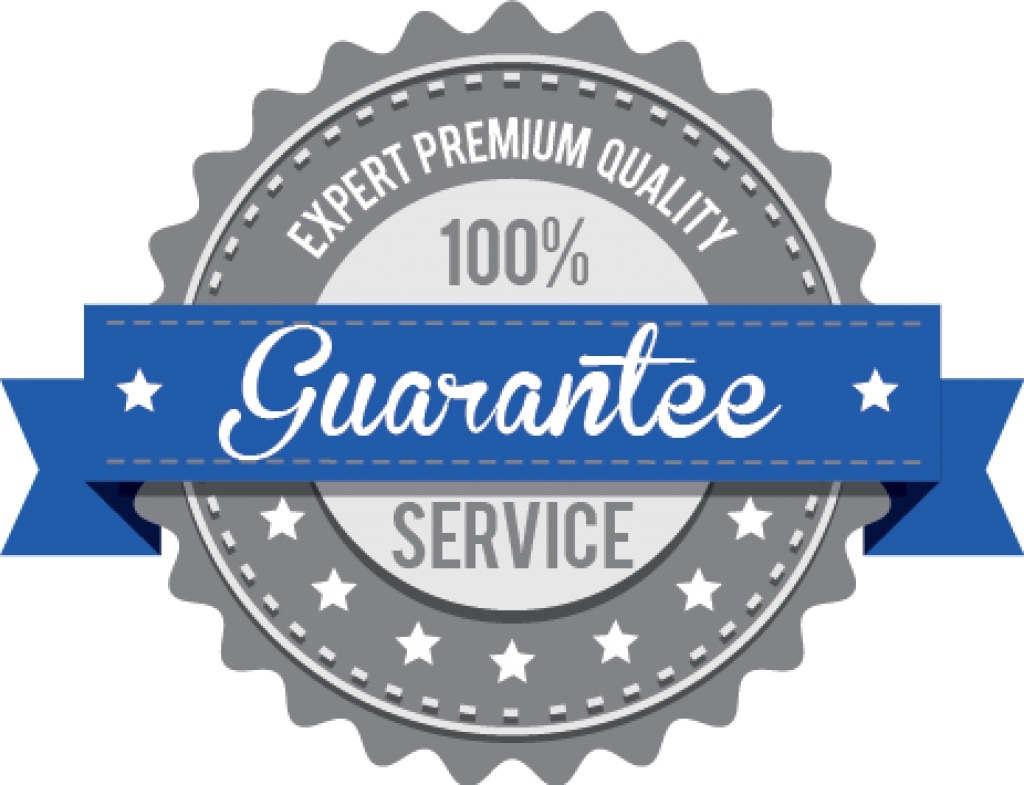
Best SEO Strategies & Tactics That Really Work in 2019
Link building has long been the most volatile field in SEO. There has been much misinformation and rancor over the best way to build links, how quickly to build links, which links to build, and even whether or not to attempt link building at all.
Table of Contents
What is SEO?
Let’s start by taking a look what search engine optimization actually is. Search engine optimization (SEO), according to Wikipedia is: the process of affecting the online visibility of a website or a web page in a web search engine’s unpaid results—often referred to as “natural”, “organic”, or “earned” results. Let’s translate that to everyday language:SEO is the process of optimizing your online content, so that search engines show it at the top of the search engine page results (SERP). What does that mean? It means that if, for example, you have a website that sells handmade jewelry, you can use SEO methods to optimize your website, making sure that when someone searches for handmade jewelry your site appears at the top of search results. Here’s an example of search engine results page (SERP):
Depending on the keyword, the first 3-4 top spots will be usually taken by paid search ads, and below that you will see un-paid (“organic”) search results. Every time you search for something, search engines like Google, Yahoo! or Bing will show you relevant results based on a number of criteria: your search query, location and so on. But SEO is not simply a tool for getting free traffic to your website. Sure, that’s one of the main advantages, but the whole idea behind it is (or should be) is to optimize your website for search intent. Search intent is the reason why somebody starts a search query. In some cases it can be simple: if someone searches for “buy DVD’s online” that person is most likely looking to buy DVD’s online.

On-page and off-page SEO
There are two broad categories of SEO: on-page SEO and off-page SEO. On-page SEO refers to all Google’s ranking factors that are determined by directly looking at the page you’re trying to optimize, such as: headlines, HTML tags, content, keywords etc.Off-page SEO refers to all the variables Google looks at, which are not exclusively in your hands, such as: number of links to your page, social media mentions, guest blogging etc. Both these elements are important in SEO strategy.
Don’t be afraid of link building. No, you shouldn’t be pulling any old-school link wheels, but neither should you be afraid of creating and unleashing a link-building strategy.
Unlike in the past, when a link was a link was a link, effective backlinks today share a few key characteristics.
First, they occur naturally. Rather than being compelled to add a link to your site for whatever reason, website owners link to yours because your content is too terrific to pass up on.
What makes a backlink high quality is subjective, and every SEO consultant will have at least a slightly differing opinion on the topic, however, most would agree that a good quality backlink would be comprised of several of the factors listed below, and that a backlink that ticks all of these boxes would be the perfect backlink.
It would be unrealistic to expect all of your backlinks to be perfect, and just because a backlink doesn’t meet all of these criteria it doesn’t make it low quality. If you can get a backlink to your business’s website that ticks at least a few of these boxes then it’s definitely worth having in your site’s link profile.
- From a relevant source
Search engines want to provide relevance in their search results, and so it’s logical that relevance is a consideration when they evaluate backlinks, which are the primary factor affecting where sites rank in their results. A backlink can be relevant on different levels. Search engines consider the overall relevance of the linking site, the relevance of the specific page with the link on it, and the relevance of the content directly surrounding the link.
- From a trusted source
It’s logical that a high quality backlink would come from a high quality website, and that a high quality site would also be a very trustworthy site. To determine if a website is trustworthy, search engines use a set of trusted seed sites (for example, Wikipedia, BBC, The Huffington Post, etc.), which they know for sure are high quality and which are difficult to get links from. The fewer the number of links away a site is from one of the seed sites, the higher its TrustRank is, and the higher the quality a link from that site is.
- Sends traffic
This aspect of backlinks too often gets forgotten about. The original purpose of links, before the time search engines started using them as a factor in their algorithms, was to add value to a page by directing visitors to resources relevant to the topic of that page. Visitors still click these links as often as they did when the internet was first created, and having a link in a prominent position on a highly visited page makes it high quality because, regardless of rankings, it will bring your website a continual stream of targeted visitors.
- On a page with PageRank
PageRank (PR) is the most basic and obvious measure to use when assessing the worth of a backlink – the higher the PR of the page where the link is located, the higher the quality of that link. PR can be a misleading metric though. All webpages start off with a PR of 0 (or n/a to be precise) and the PR of a page can rise and fall over time. Also, the PR value that Google displays for a page is only updated for the general public every 3 or so months, but within the algorithm it’s updated constantly. So, the PR value you see is only an estimate, and could well be a point or 2 off of the true PR.
- Next to backlinks to authority websites
If a backlink to your business’s website is included on a page that links to high quality sites, especially ones in the same niche as your site, then it indicates to search engines that your site should be put in the same bracket as those high quality sites. If the other links on the page are to low quality sites, then your site won’t necessarily be classed as low quality also, but rather search engines may opt not to include those links as a factor, either positively or negatively, in their ranking calculations.
- Not reciprocal
Link exchanges were widely abused in the past, which resulted in the value of reciprocal links being reduced. Reciprocal links do still have value, and there’s certainly no risk of a penalty being applied as a consequence of them, however, if you’re looking for a backlink of the highest possible quality, then it should come from a website that you’re not also linking to from your own site.
- Not easily acquired
The more easily you can acquire a backlink, the less value it will likely have. The chances are that if you can get it a couple of minutes, or with a couple of clicks, then thousands of people will have done it before you and thousands more will do it after you – including your competitors if they take the time to review your site’s backlink profile. If a competitor replicates one of your links then the value of that link to you has been neutralised in your head-to-head SEO contest with that particular competitor.
- Not paid for
Paid links can, and often do, improve rankings, however, they can’t be classed as high quality backlinks because of the risk they carry. Search engines explicitly say that purchasing backlinks for the purpose of improving the rankings of your website contravenes their guidelines, and that websites found to be doing so may be penalised. The payment doesn’t need to be made directly to the website linking to you either, it can be via a 3rd party linking scheme, such as a blog network.
Best SEO Practices That Really Work in 2019: 30-Day SEO Action Plan
The first step in your 30-day plan is to identify authority websites relevant to yours.
You can easily use Google for this. Use search operators to zero in on suitable sites more quickly. For example, use site:.gov, .edu, or .org to limit your search to such sites.
Search for the keyword of your choice to find sites that rank highly for it, and go from there.
Another option is to use the Moz SEO toolbar, which is offered as a free extension for Firefox and Chrome.
It displays useful metrics and information about the site you are currently visiting, including its page authority, domain authority, links, and a general analysis of the page itself.
What to offer
Okay…so far, so good.
Here’s the rub, though: You can’t approach these authority sites without offering anything in return.
Since your website is brand new, what can you possibly offer?
I hate to break it to you, but you should ideally build up a decent content library before attempting to solicit backlinks from authority sites.
Luckily, the content doesn’t have to rank well. It just has to be top-tier in terms of the quality of the information it provides.
Prior to launching your site, devote a few weeks to developing a small arsenal of content. When the time comes to work on your link-building strategy, you’ll have stuff to offer other website owners.
After all, why would they link back to you if you have nothing for them to link to in the first place?
Making contact
When it comes to approaching website owners for backlinks, you already know what to do. Navigate the site in question to track down contact information.
If you can’t snag an email address, use a contact form.
Don’t be blatantly promotional. In fact, you might even hold off broaching the subject until you’ve had a few exchanges.
Flattery will get you somewhere, so try breaking the ice by complimenting the site owner on a piece of content.
Later, show them some of your stuff, and suggest swapping links.
1. Blog – A LOT
According to HubSpot, companies that blog on a consistent basis have up to 97% more backlinks than those that don’t. From day one, commit yourself to posting new posts consistently.
Quality still counts, though; so, create a schedule that allows you to post regularly while offering readers real value.
2. Offer free resources
You’ve got something to offer free, right?
Like you, other website owners are always looking for useful, credible sources of information. There’s no reason why you can’t provide it.
Create a library of white papers, e-books, and other pieces of content that provide detailed, useful, and well-researched information.
Offer these resources free, but make one small request: credit in the form of a link back to your website.
Alternatively, offer the content free as long as it’s directly linked to from your site.
3. Become a PR whiz
When they’re done properly, press releases can effectively plant seeds for new backlinks to your site.
By “properly,” I mean that they provide newsworthy information and that they include a non-promotional link back to your site.
Reserve press releases for truly newsworthy events.
You should have plenty to go on with a new site since so many things are in the hopper.
4. Create and share infographics
Breaking up text with high-quality images is smart.
Not surprisingly, there’s a strong demand for top-notch images online, and infographics are especially popular. Build a library of infographics that relate to your industry or niche.
Whenever possible, create an infographic for an important trending topic that affects your industry or business. Readers love to share newsworthy graphics and use them as a form of social currency on social media.
Sprinkle in a bit of SEO to ensure your infographics are easily found through the search engines.
People will want to share and use your infographics. When they do, organic, high-quality backlinks to your site will ensue.
5. Develop charts and tables
Humans are visual by nature, so charts, tables, and other visual representations of data tend to go over very well.
Load your site with tables and charts pertaining to your niche to plant the seeds for more backlinks.
You don’t have to be a data scientist to make this happen. Find reliable sources of information, and put their data into graph or table form.
Use a site such as OnlineChartTool.com to quickly and easily create eye-catching charts and graphs others will gladly link to.
6. Build an image library
Website owners are always looking for images in general—especially if they are offered free.
Make sure the images are of high quality. If you don’t possess the skills to take excellent photos yourself, you need to be willing to hire someone who does.
Post each image on its own page. Include a detailed description, and use SEO best practices to increase the odds of it ranking well in Google Image Search.
Include a form for quickly grabbing the file and link code to ensure you get your links.
7. Repurpose effective content
A quick note: never, ever copy content from the Internet.
I’m not just saying this because plagiarism is wrong; I’m saying it because Google will penalize you so hard that your site may never recover.
That being said, there is nothing wrong with identifying useful pieces of high-ranking content from other sites and repurposing them to suit your needs. But make them truly your own by optimizing them to be relevant to your website.
And don’t just repurpose text-based content as text-based content.
Take a text-based piece and turn it into an e-book, an infographic, a video, or some other form of media.
8. Fill a gap
Yes, the Internet is jam-packed with content.
Chances are, much of what needs to be said regarding your niche or industry has been said. Still, others have surely overlooked important topics. Identify those gaps, and fill them with high-quality content of your own.
Similarly, look for gaps in the types of available content. For example, perhaps there’s an overload of posts and articles about a subject but no in-depth pieces or e-books.
Be the first to provide them, and you will reap all kinds of great link karma.
9. Interview influencers
Seek out influencers within your niche, and create a roundup post.
Such a post essentially includes several links to several different influencers while covering a specific subject.
A great way to round out this type of content is by interviewing the influencers in question. After finding key influencers, follow them on social media. Interact with them to establish a relationship, and then approach them about interviewing them.
Even very busy influencers can usually take time to answer a question or two via Twitter or another social media site, so this is a worthwhile option to consider.
10. Scope out the competition
What kinds of backlinks do your competitors have?
Chances are, you could benefit from receiving links from similar sources too. Do a little sleuthing to discover who’s giving them link love.
Use a site like SEMrush.com to track down your top competitors based on relevant keywords. Next, input each competitor’s URL into a site like OpenLinkProfiler.org.
You’ll get a list of links to your competitors’ sites, and you can follow them to see where you might want to concentrate your efforts.
11. Try broken link building
This technique is especially valuable for new websites.
Put simply, you seek out broken links on relevant websites and approach site owners with replacement content they can link to instead.
Since 404 pages can negatively impact a site’s ranking, website owners usually appreciate being alerted to the issue. Use something like the iWebTool Broken Link Checker to search a specific URL for dead links.
Contact the owner, but make sure you have something for them to link to instead.
12. Make useful comments
In the old days, conventional wisdom said to post links back to your site in comments sections to boost your link profile.
These days, that comes across as spam, so you need to take a subtler approach.
You need to keep up on industry news anyway, so get into the habit of regularly reading relevant blogs and websites. When you have a useful comment to contribute, do so.
When someone comments on your site, acknowledge the comment!
Chances are, they’ll remember the gesture and reciprocate in the future. Even if they don’t, it’s good karma.
13. Write guest posts
As you already know, generating enough content for a business isn’t easy.
Site owners are often happy to be offered free content for their sites, and you can do so by offering to create guest posts and articles for them.
Get to know a website or blog before approaching the owner. Make sure your content complements theirs. Have a unique angle or insight to offer, and then make your pitch.
One more thing: reciprocate by offering to let them guest-post on your site too.
14. Harness the power of social media
Your site is new, so your social media game has to be strong.
Whenever you create new content, promote it across all social media channels. Even if each post generates only a few shares, the odds of backlinks being generated increase.
Later, don’t be afraid to promote old content on social media again. You may have new followers now, so it certainly doesn’t hurt.
15. Keyword Selection – keyword selection is probably the most important part of the entire process. Thankfully, there are some readily available tools that can make the process a lot easier. SEMrush is one such tool that will allow you to see what keywords your competitors are ranking for and how much traffic they estimate each keyword is sending to their site.
If you are new to finding keywords, this is one of the easiest ways to find some quality terms to target, but I also suggest checking out the keyword research guide from Brian Dean before settling on your target keywords.
16. Competitive Research – Identifying your top competitors is also very important. Finding sites that rank for the terms you wish to target can help you develop a roadmap to follow. The best way to find “online” competitors is to complete various searches for your products or services (in your area if optimizing for local SEO) and then record the sites that appear the most often. Those sites are likely to have a strong SEO strategy. You should review the keywords, citation profile, link profile, meta data and the content of competitor sites.
17. Google Analytics Setup – Analytics will provide you with a wealth of information about the progress of your website. Traffic, conversions, user behavior, popular pages, and so much more can be collected and reviewed for free. Google also offers free training for Analytics so there is no excuse not to set up and use it!
18. Google Search Console Setup – Search Console allows you to view which pages on your site Google has indexed, what terms people are searching to find your site, and it is used to notify you if your site is hacked or manually penalized. Set it up and verify your site, then re-visit in the near future when it comes time to submit your sitemap.
19. GMB SETUP – If your business has a location that customers can visit, you should setup a Google My Business listing. If you want to rank in the local search results, it is vital that you complete this step. To register visit this page and follow the directions: https://www.google.com/business/. Take the time fill in each field with as much detail as possible, this will save you time in the future. (Image source, Google.)
20. Website Technical Audit – There are a number of issues that your website could have (too many to list) so you need to run or have someone run an audit to pinpoint the exact issues your site has. SEMrush offers a good site audit tool, Screaming Frog is nearly the industry standard and Website Auditor from SEO PowerSuite is also a great option. More importantly, take advantage of the educational material from each service to understand the results and how to correct them. If you are not familiar with website coding, you may need the help of a web developer to correct some of the issues.
21. Website Speed Review – Site speed is important to Google and people trying to visit your website. GTMetrix is a free tool you can use to scan your website and make sure it loads quickly. If your website has speed issues, the tool will outline them so that you can correct those issues. Again, a Web developer may be needed to correct some of the issues if you are not familiar with coding.
22. Link Audit – Low quality backlinks can cause website penalties, de-indexation, or at best, can act as an anchor, reducing the effectiveness of new links built to your website. Additionally, knowing a websites past is the best way to plan for the future. Link Research Tools is a good option but you have to set it up correctly for maximum results. If you are new to SEO, you should enlist the help of a professional for this critical step, if you are more advanced, make sure you closely check the anchor text ratios, look for links with “money keyword” anchors, and links from sites that are not indexed.
23. Create and Upload a Disavow File – Upon completion of your link audit, a disavow file should be created and uploaded to Google Search Console. This is a more advanced activity so, if you have a professional complete a link audit, you should also have them create and submit the disavow file for you. If you want to tackle this yourself, check out The Complete Guide to Disavowing Links for Google and Bing.
24. Content Audit – There are a number of reasons why you should audit the existing content of your site. Poor content can lead to content-related penalties and poor user engagement, all while making it difficult (if not impossible) to rank. While auditing the content on your site, you should be comparing content length and keyword density to that of your competitors.
You should also make sure that you have pages targeting the keywords you identified during keyword research, and if not, add them into your content calendar to be created. If you are ready to go beyond those basic steps, check out this content audit guide from the Moz blog. As you complete the audit, be sure to make simple spreadsheet that allows you to pair keywords to specific URLs, this is often called a keyword map and it will help you keep things organized in the coming months.
25. Page Title & Meta Description Reviews – Upon completing your content audit, you should have a good idea of which pages will target which keywords. This is where competitor research can once again come in handy. For each page on your site that you want to rank, check out the page titles and meta descriptions for the top 5-10 ranking pages. Here are some questions to get you started.
- Do titles all start with the main keyword?
- Are more than one of your competitors targeting the same long tail keywords in their title?
- What pain points are they touching on in the Meta description?
- Are multiple competitors highlighting the same feature or benefit?
- Are there paid ads for those keywords?
- What features or benefits are being promoted most in the paid ads?
Gather all of that information and it will create a basic roadmap for you to follow. That is not to say you should copy your competitors directly, just that you should take note of the key points and include them in your own titles and Meta descriptions to entice more people to click.
26. Corrective Planning – Once you have gathered all of the information you need to start optimizing your website, you need to plan out how you will go about correcting those issues. This will be largely dependent upon your knowledge prior to conducting the audit and how much free time you have each month to work on these issues. Moving forward, you should map out the following:
- What technical SEO issues were discovered? Will you correct them or hire someone to make those corrections?
- What issues are slowing down your website load times? Is correcting those within your skill set or should you hire someone to assist in making those changes?
- How was the backlink health of your website?
- Do you need new links to replace disavowed links?
- Do you need to dilute your anchor text ratios?
- What content needs to be created?
- What existing pages need more content?
- Do you need website pages or blog posts?
- How many page titles and meta descriptions need to be modified?
Search engines don’t just read your website’s text – they also read your code. Optimizing your code is a crucial part of on-page SEO. There are eight elements of code you need to need make sure are optimized. These are:
- Title tags
- Meta tags
- Headings
- Sitemaps
- Domain name
- URL structure
- Site structure
- Alt tags
- All these elements of code contribute to overall ranking. The better they’re optimized, the more “points” you get with Google when it crawls your page.
28. Find and Fix Broken Links
404 error example.pngWe’ve all clicked on a link only to find a 404 (file not found) error. It can be incredibly frustrating — for human users and search engines alike.
These 404 errors are most commonly caused by broken links, which are hyperlinks that director a reader to an incorrect or nonexistent URL.
Broken links aren’t only a frustrating problem for readers; search engines will find all 404 errors on your website, too. The more errors an engine finds, the less well maintained it assumes your page is and the lower your ranking will be.
29. Refresh Your Redirects
Redirects are simply part of operating a website, they’re pretty much unavoidable. But if you’re smart about it, they don’t have to hurt your rankings.
Status code 302, a temporary redirect, is the most common redirect. They’re used a lot during server relocations, redirecting URLs until the new server is established. The problem is that they’re often left permanently, even though there is a unique status code for permanent redirects: 301.
Review your redirects, keeping only the 302 redirects that are truly temporary, changing the rest to 301s.
30. Strategic Link Building
Now that you know links are important you need to get a lot more of them.
But, you don’t want just any links…
You don’t want Spammy links that have no relevance at all to your site. Don’t fall for the shady operator on the net who is like a street corner hustler whispering “Pssst, hey buddy I got some links for you…. How much you got?”
Most people forget that it’s not just about quantity it’s also about quality
What’s this mean?
Well, good ‘ole Google the ever-watching deity of the net has decided that when links are easy to get, or come from forum spamming or other means that it will devalue them…
and so, directories and other sites are no longer as highly valued by Google.
Top ranking websites have good link diversity which means that links come from many different places and not just several spammy sites over and over.
In addition, links need to come from high DA websites.
What you need are a large number of diverse links from high DA sites in order to get a boost in SERP results
Let’s talk about some proven ways to get these kinds of links:
- Round-up style content is excellent for this – That’s a post that sites multiple top influencers in your niche or field.
These type of posts have been shown to get more backlinks.
So, find and publish input from influencers in a roundup style post both to get links and as a way to produce great content.
Here’s another method to rank higher:
- Write quality content more frequently.
Both quality and frequency play a role in rankings…
According to HubSpot, companies that post blog posts more frequently get more traffic.
In addition, you get more inbound links… The reason for this is that you are creating a reciprocal cycle in which you rank more highly in google and as a result get more traffic and more links.
- So, if you can’t compete with links compete with posting frequency.
It’s a great strategy to generate more traffic and make up for a lower rank.
Here’s an equation for you:
- More Posts=More Indexed Pages=More Traffic
As soon as you develop content, it is possible to campaign for links to boost that content.
You can outperform sites with multiple approaches.
You can outrank competition for one article or you can write five articles which can generate more traffic. If I were you I’d focus on generating more traffic.
Now comes quality:
As a strategy to increase profit Google is focused on creating the best possible user experience for their search engine.
They care about quick, effective and relevant content delivery free of Spammy results for their users.
If they don’t do this then one of their competitors such as Yahoo or Bing will eat their lunch.
Googles understands that if someone modifies their search engine results after the first search that the content was not as relevant to the user.
Also, if someone sees your article and quickly clicks away from it google knows about it – Remember the dwell time metric.
This means that you need to care deeply about the consumer experience for your content, in the end, that’s what Google cares about too.
It means stop keyword stuffing and start writing quality content or get someone else to write it for you.
You need keywords in your content, but keyword stuffing is out and you also have to be careful of over-optimization which is when your content looks like it was written for the search engine and not the user.
Look, we’ve all been there we just have to stop going there…
A key understanding with modern SEO and increasing rankings in SERPs, is that now you need to have an understanding of copywriting and writing appealing content.
That’s all there is to it. If you have any extra 20-50 hours this month, follow the checklist above and your site will be in a lot better shape than when you started. If you don’t have the time to spare, you know what to do. Either way, SEO is very powerful means of marketing for small business and failing to take action will cost you big now and in the very near future.
Conclusion
Additionally, just because you rank well for one keyword or key phrase, does not mean you will rank well for a similar key word/phrase. And remember that Google is constantly updating their ranking algorithms so today’s rankings may not equal tomorrow’s rankings.
Expect to see your site move up and down in the rankings on a daily or weekly basis – it may even drop from the rankings altogether. This is why SEO should always be ongoing.
Remember, your competitors are likely following the same protocols you are. They are likely optimizing their web presence using the same methods you are using. Keep blogging and getting links. Improve the content you already have on your website. A lot of diligence and patience will prove to be worth it when you get that coveted spot at the top of Google page 1. Depending on your business, it could literally be worth millions of dollars in revenue. Something that valuable will never come easy.
Get Ahead of Your Competitors in the Search Engine Results Page
With Our SEO & SEM Services
None of this matters if you rank behind your competitors. That’s the point, right? Outrank your competitors in Google’s search results?
Getting on the first page of Google in 24 hours isn’t realistic if you don’t have a partner that knows what they’re doing. Give me a call, and we can talk about a unique strategy for getting your business on the first page of Google.





















